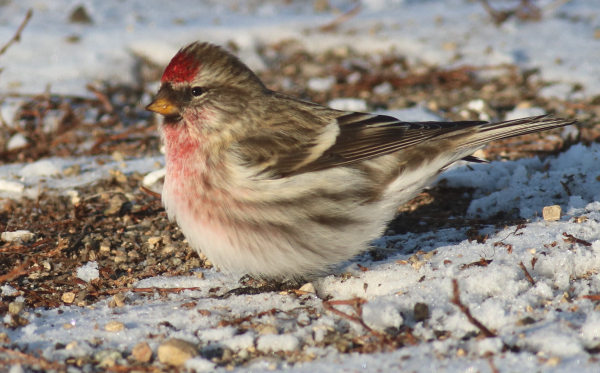
Common Redpolls may soon be lumped with other redpolls into a single species (photo by Paul Konrad).
|
For birders trying to figure out if there is a Hoary Redpoll among the flock of Common Redpolls they’re viewing, new research from the University of Colorado in Boulder indicates: Don’t worry, all redpolls are actually the same species. Recently published in Nature Communications, the study found that the 3 species of redpolls – Common Redpolls, Hoary Redpolls, and Lesser Redpolls – are really all the same species, genetically speaking, as new technology has provided new insights into the taxonomically confusing repolls.
The new genetic research found that the 3 recognized species are a single species with a “supergene” that controls differences in plumage color and morphology, which makes them look different. This research builds on information provided by a 2015 study that suggested this might be the case without having a clear explanation about why it was so. This time, with greater genetic technology available, the researchers were able to look at the full genome of the 3 different species. And they found that what commonly signifies different subspecies in birds doesn’t apply to redpolls.
“I think, solidly now, the new research shows there is widespread gene flow across the redpolls’ genome, except for in one region, and it just so happens that one region influences the way they look,” said Scott Taylor, assistant professor in the Department of Ecology and Evolutionary Biology, director of UC Boulder’s Mountain Research Station, and an author on the research publication.
Redpolls are a “winter finch,” or a finch that lives in the Arctic, with some repolls migrating south sporadically during winter. While known for the characteristic red spot of plumage on their head, the appearance of individuals within the species can vary, with some redpolls colored mostly white with small bills, while others are browner in color, and some have larger, darker bills. It was formerly believed that these differences signified 3 different species of the redpolls, but as with many other bird species – “species” can sometimes be difficult to differentiate.
“Redpolls have been taxonomically confusing for a long time, and we only get to see them every once in a while during winter,” Taylor explained. “They aren’t a bird you’re guaranteed to see at your feeder, so when they do appear, people get excited and they want to know what they’re looking at.”
In 2015, Taylor and graduate student Nicholas Mason, now an assistant professor at Louisiana State University, found preliminary genetic data suggesting the redpolls were all a single species with different appearances – but the researchers weren’t quite sure why. The results of the new research picked up where the 2015 effort left off, with Erik Funk, graduate student at UC Boulder and the lead author of the paper, re-examining the original DNA samples and adding a few more from other regions of the world, including Greenland, Iceland, and northern areas of Europe to get a more complete picture.
Altogether, Funk examined the full genome of 73 individuals from the 3 different redpoll subtypes, including Common Redpolls, Hoary Redpolls and Lesser Redpolls. What he found is that, despite the differences in appearance, all redpolls are almost identical genetically except for a “supergene” that controls the different traits that make the redpolls appear to be different. In particular, the researchers found a chromosomal inversion allowed this supergene to be created.
“Often we assume that a lot of traits can act independently, meaning that different traits can be inherited separately from one another. But this particular result shows that sometimes these traits are actually tightly linked together. At least for these redpolls, they’re inheriting a whole group of traits together as one,” Funk explained.
While the researchers now have an answer as to why this species’ appearance varies, questions still remain as to how these traits are maintained. And will that change with Arctic warming for these Arctic specialists?
“Sometimes birders get mad if you take birds off their list, but I think it makes redpolls even more interesting,” Taylor said. “Understanding the genetic basis of the trait makes it pretty cool.” For now, the 3 redpoll species remain, until the American Ornithologists’ Union makes any name and species status changes official.
Other authors of the research and publication include Snæbjorn Palsson from the University of Iceland, Tomas Albrecht from Charles University in Prague and the Czech Academy of Sciences, and Jeff Johnson from the Wolf Creek Operating Foundation. To refer to the original article, see Common Arctic finches are all the same species: New research confirms that there are not, in fact, multiple species of Redpoll Finches, as previously thought -- ScienceDaily